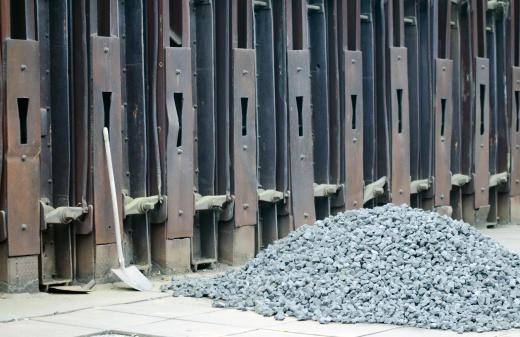Calcium carbide is a compound produced from a thermally converted combination of coke and lime. It has several industrial applications, the most frequently encountered being the production of acetylene gas. Acetylene is widely used as a less costly alternative to traditional petroleum-based heating fuels in a number of industrial processes. Raw calcium carbide finds additional uses in the steel production industry as a desulfurization and deoxidizing agent. Less common industry applications of calcium carbide include fuel for carbide lamps, the production of polyvinyl chloride (PVC), and fruit ripening.
The acetylene producing characteristics of calcium carbide have been used for many years as a fuel source for illumination, furnaces, and cutting or welding. A product of the high temperature conversion of coke and lime mixtures, calcium carbide produces large quantities of acetylene gas when exposed to water. Prior to the development of viable electric lighting, raw lumps of the compound were widely used in combination with water to produce acetylene burned in carbide lamps to provide illumination for underground mining operations, automobiles, and street lighting. These primitive yet surprisingly effective lamps may still be found in mines in several developing nations. Although several other industry uses for the compound have emerged over the years, the most prevalent contemporary application of calcium carbide is still the generation of acetylene gas.

Acetylene is an effective and relatively cheap source of fuel for a number of industrial processes particularly in developing countries where it is used as an immediate fuel source and to generate gas for bulk storage. Its ease of manufacture, low cost, and simple conversion to gas make it an attractive alternative to mainstream fossil fuel heating sources. Acetylene is also extensively used world wide in oxy-acetylene cutting and welding applications. The gas is also used in the chemical industry for the processing of several compounds, the most notable of which is raw PVC.

The iron and steel industries use both raw calcium carbide and acetylene in several production processes. One such application is the desulfurization of pig iron, cast iron, and steel. It is also used in several related applications as a potent deoxidizer. Acetylene gas is often utilized in this industry sector as a heating fuel for specific process applications.
One of the lesser known applications of acetylene gas is found in a somewhat unusual industry sector. Commercial fruit farmers generally pick their crops before they are fully ripe because green fruit is easier to ship. Prior to sale, the green fruit is exposed to either ethylene or acetylene gas which acts as a hormone stimulator hastening the ripening process. In several Asian countries, the fruit is simply placed under bowls along with a couple of lumps of raw calcium carbide where moisture in the air causes the release of acetylene gas.
